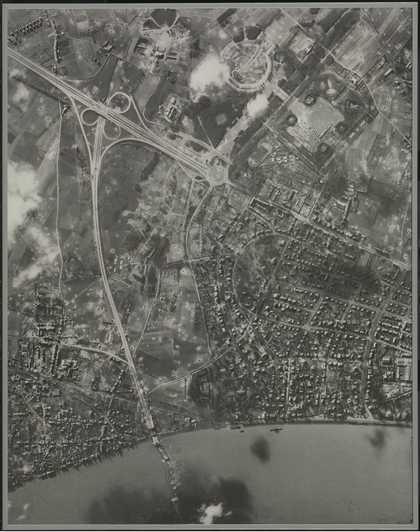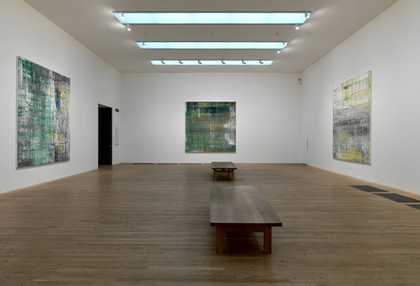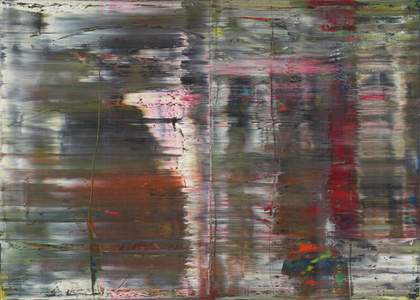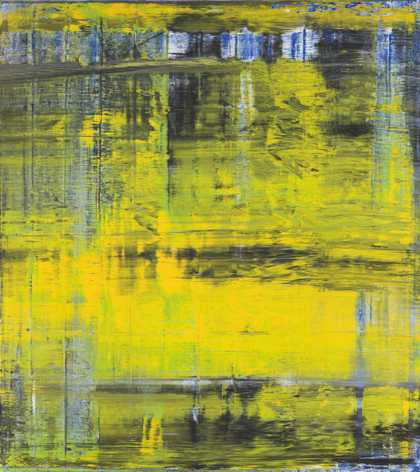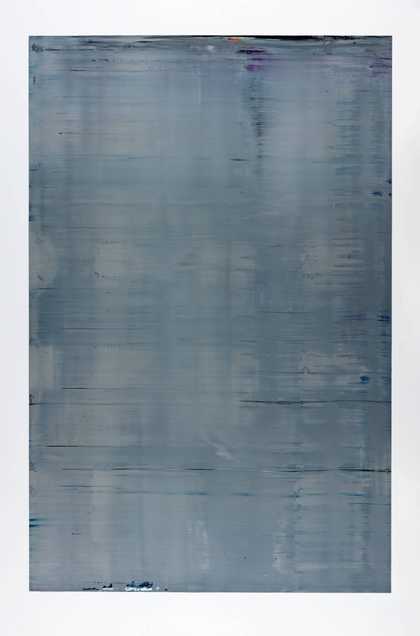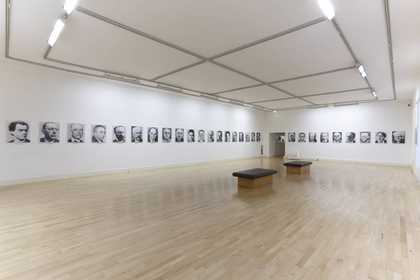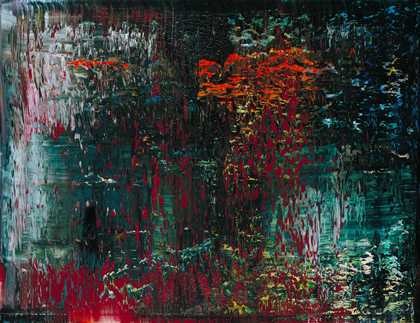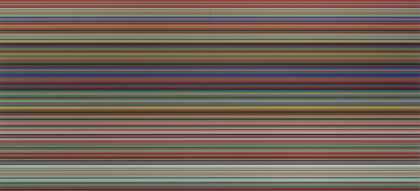Spanning nearly five decades, and coinciding with the artist’s 80th birthday, the exhibition Gerhard Richter: Panorama groups together significant moments of his remarkable career.
Since the 1960s, Gerhard Richter has immersed himself in a rich and varied exploration of painting. Gerhard Richter: Panorama highlighted the full extent of the artist's work, which has encompassed a diverse range of techniques and ideas. It includes realist paintings based on photographs, colourful gestural abstractions such as the squeegee paintings, portraits, subtle landscapes and history paintings.
Richter: I’m not very good in speaking and I couldn’t be a politician.
This painting is very different, you do what you want; you feel very free when you paint. I had always the feeling, I wasn’t sure that I’m good, not at all, but I was always sure, I’m allowed to do this.
Serota: Gerhard, hi.
Richter: Hi Nick.
Serota: Hi, how are you?
Richter: Good to see you.
Serota: Good to see you. Are you well?
Richter: Okay, yeah.
Serota: Hi. Morning.
M3: Morning.
Serota: So what have you been doing? I’m going to have a coffee. Is this for me? Thank you. So good to see you. You’re looking well.
Richter: I slept badly.
M3: The two main things to talk about are the cover and the subtitle.
M4: Let’s concentrate on the show and then come to the catalogue, shall we?
M3: Sure.
M4: So have you talked about Baader-Meinhof?
M3: Yes.
M4: You’ve done that? Okay.
Serota: So, Gerhard, what made you feel that you wanted to be a painter?
Richter: It was so long ago to ask these things. I started to paint it was the only thing that helped me. It was good. I had an interest.
Serota: And then you went quite early to the academy in Dresden.
Richter: Oh, it was fantastic to make drawings and paintings and very realistic and technical. It was a very solid education, what we learned, what is canvas, what is this, what is this.
Serota: So you learned the craft of painting.
Richter: We learned a lot there.
Serota: Do you think that teaching was a better education than you would have had in West Germany?
Richter: It was in any case different. I was shocked when I arrived here and studied another year in Dusseldorf. They didn’t start at eight. I was the only one at eight in the morning.
Serota: You were the only person starting at eight in the morning.
Richter: I was used to, it was good.
Serota: So this must be the first time that the Cloud paintings have been seen for a long time.
Richter: Yes, it’s good and here we have more…
Serota: More space.
Richter: Yes, if don’t we could…
Serota: I think it would be better to leave the mirror on its own, yes definitely.
Serota: But then you decided to leave the east, was that for personal reasons or for artistic reasons.
Richter: It was terrible there. Not only not free, it was really terrible and we had also the possibility to go every year at least twice to West Berlin and saw movies and exhibitions. It was the first time I saw the wonderful The Family of Man, was a famous exhibition.
Serota: This was the exhibition made by Edward Steichen.
Richter: This was a real shock for me this show.
Serota: Why?
Richter: Yes, to see these pictures, because I only knew paintings. I was very interested and they showed so much and they told so much these pictures, these photographs, told so much about modern life, my life.
Serota: So was this the moment when you discovered photography or the power of photography?
Richter: The power, yes, what photography can do.
Serota: To see The Family of Man was to understand how a photograph could capture a moment or a place or a person or an image.
Richter: Yes, that’s what we knew.
Serota: At what point did you start to tear images out of magazines and keep them?
Richter: Perhaps when pop art started. Pop art give me a, no an...
Serota: A licence.
Richter: A licence yes, to use these things for paintings.
Serota: And this was also true for Polke and for Konrad Lueg.
Richter: Yes and for many others.
Serota: How did you select these images from magazines?
Richter: Maybe I tried to avoid these images what Warhol took or Lichtenstein. What interested me. I don’t know.
Serota: But you also chose some images of your own family.
Richter: These were interesting photos, but never was a photograph, it was not styled. It was snapshots. It was banal photos I was more interested in, not the artificial.
M5: In the workshop with just two assistants, we start preparing everything what is necessary for the paintings and if Gerhard wants to paint, normally a few weeks earlier he orders the sizes of the canvases and asks us to prepare the paint. Now here we are in storage. Some of the prepared frames, at the other side we’ve got some ready ones packed, numbered. If he starts realistic painting, if he works on it in the breaks he put on such things here that’s guaranteed that there is no animals coming into the pictures and also it dries not so fast because the last step is normally that he uses a thicker fine brush just to un-sharpen them.
Serota: So the images that you were using are usually taken from…
Richter: My own.
Serota: Increasingly from your own.
Richter: I bring the photographs.
Serota: Yes.
Richter: Yes.
Serota: And you have this great collection of photographs which you call the Atlas.
Richter: The Atlas comes when everything is done. No more paintings from this subject. No more, this is done.
Serota: So in a way it’s an edited version of your life or your thinking.
Richter: Yes.
Serota: But in the late ’60s you were already becoming quite well known as a painter…
Richter: Of photographs.
Serota: …of photographs and a painter of images.
Richter: Yes.
Serota: And then you began to make paintings that were abstract paintings. It wasn’t a good move for the market, was it?
Richter: No.
Serota: So why did you do it?
Richter: I was a bit afraid I would become a specialist for photo painting, so I made abstract and I discovered the pleasure, the fun, it was good. The one step to abstract painting was great, it was great painting it]. I was so unsatisfied with what I did and it was a bad painting so you feel helpless and you destroy it and over paint it and you discover that it has a quality, a very special quality. It tells in a way the truth, but it has to look good. This is hard to explain.
M5: This is the first studio; the big studio, normally he paints here directly with maybe up to eight paintings at the same time. Normally it’s so that he would paint a few hours in the morning and then he has a break and then we clean up and afterwards if he wants he can paint again. So this is the process and we’re working together and between painting and cleaning and painting and cleaning for weeks, sometimes for months. Normally we prepare the exhibitions in the other studio because we don’t have enough space here, but now for today we brought this model here, a model from the Tate Modern in London for the exhibition. This is a new development for us, it is magnetic so it’s easier to handle them and to remove them. It’s great fun, every director, curator coming here to see this museum magnetic, they play with it, they love to play with it.
Serota: Yes, move this one, the right hand one in to the corner. Move that to 22, make it 22, the right hand gap 22. So now move that one, the left hand one 20 centimetres to the left. That looks as though they’re supposed to be the same but we haven’t quite measured it right. Okay, swap them back then. It’s looking quite good, isn’t it and we’ll make it a little higher.
Serota: The Baader-Meinhof paintings you made nearly ten years after the event, why did you wait so long?
Richter: But this happens often, maybe not ten years, but you do it later, when you’ve had time to reflect or I don’t know, maybe something is still open and I had to close it.
Serota: The images that you chose are sometimes very inconsequential images and sometimes very consequential.
Richter: Yes, directly.
Serota: So is that how you think about painting, sometimes direct and sometimes very oblique?
Richter: About life. I guess, yes.
Serota: Are you working on both kinds of painting at the same time or you move backwards and forwards from one to the other?
Richter: Backwards and forwards, not at the same time. This is a wonderful contrast, yes, because the abstract is a lot of work like gymnastics, you really work and it's dirty and so a realistic painting you can sit… like holidays, a bit.
Serota: So these large abstracts, how do you know when they are finished?
Richter: When nothing disturbs me and I have no idea what to do more, what I could add or destroy. This is very surprising often, when I’m painting again and again every day and so I actually think it’s never ending, you will never come to an end and it will never become a good painting and suddenly it’s finished, oh, good, thanks.
Serota: We have in the exhibition several sculptures or objects. It’s unusual for a painter to make objects like this, why did you make them?
Richter: Why not?
Serota: But it’s unusual for a painter to make sculpture.
Richter: Yes, Degas made nice dancers.
Serota: Well, I happen to think that that’s true…
Richter: Picasso…
Serota: …that some of them, no, no, I happen to think that some of the best sculpture was made by painters, but why did you want to make objects?
Richter: It came to me and I said, yes, I’m allowed to do this. Yes, I wanted to, not so many, some glasses.
Serota: Some glasses.
Richter: Yes, these are not sculptures.
Serota: What are they?
Richter: I don’t know, objects.
Serota: They’re objects which are also paintings.
Richter: No, paintings, no.
Serota: Okay.
Richter: Painting is flat. Painting show what isn't there.
Serota: When I think about 9/11 there were of course these very powerful photographs that were taken on the day. What is it about your painting that makes it enduring?
Richter: The picture I used for this painting was very beautiful, with flames and red and orange and yellow and wonderful. This was the problem. Of course I painted it first really so colourful and then I had slightly, slowly to destroy it. I made it banal, it doesn’t tell much. It shows more the impossibility to say something about this disaster.
Serota: For me this painting, instead of being about a particular moment, it has a timeless quality.
Richter: That would be wonderful and I believe that all things of quality have this timelessness in architecture, in music, in literature, otherwise it’s hard to handle this life.
That is good.
This is wonderful.
It looks well doesn’t it.
Very, very well, absolutely. Very good, That is my teacher.

